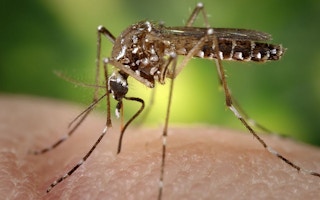The spread of Zika during 2015-16 caused hundreds of thousands of infections, a surge in cases of birth defects linked to the disease, and saw athletes withdrawing from the Summer Olympics in Rio de Janeiro.
The warm conditions of 2015-16 were “exceptionally conducive” to mosquitoes spreading the disease across the continent, the researchers say, helped by the lack of natural immunity in the South American population.
And their results suggest there is a significant risk of summer outbreaks of Zika in the southeastern states of the US, southern China and southern Europe.
Public health emergency
First identified in Uganda in 1947, the Zika virus has gradually spread through the tropics – from Africa into southeast Asia and then across many small Pacific islands.
The main carrier of the disease is the Aedes aegypti mosquito, but other species such as Aedes albopictus and Aedes hensilli spread Zika as well.
Scientists estimate that the virus first entered South America through Brazil in late 2013, though the first infection wasn’t officially recorded until May 2015. In the months that followed, Zika spread throughout South and Central America and even into the US.
In February this year, the World Health Organisation declared the outbreak a Public Health Emergency of International Concern. The designation was lifted about a month ago, but Zika remains a “significant enduring public health challenge requiring intense action.”
The new study, published in the Proceedings of the National Academy of Sciences, finds that the outbreak was very likely fuelled by the unusually high temperatures of the last two years – a result of a very strong El Niño event on top of ongoing human-caused climate change.
El Niño is a weather phenomenon that originates in the Pacific Ocean, which tends to increase global temperature for a couple of years by releasing heat from the ocean to the atmosphere. The El Niño that developed in 2015 – and petered out in June 2016 – was one of the strongest on record.
Climate influence
An outbreak of Zika needs three main ingredients, says lead author Dr Cyril Caminade, a research associate in the Institute of Infection and Global Health at the University of Liverpool. He tells Carbon Brief:
“The minimum requirement for a vector-borne disease outbreak is the presence of competent mosquito vectors (Aedes mosquitoes), the presence of the pathogen (Zika is believed to have entered Brazil in 2013 but the World cup in 2014 must have helped too), and the presence of a suitable host (humans).”
There are then a series of factors that affect how far and how quickly an outbreak can spread. Some are socio-economic – such as poverty, access to sanitation, and the availability of healthcare and vaccines – but the climate ultimately “sets the background” to disease transmission, Caminade says.
The distribution of mosquitoes, how long they live, how often they bite, and the incubation period of the virus – i.e. how quickly mosquitoes become infectious after biting an infected person – all tend to increase in warm conditions, Caminade says. And heavy rainfall creates pools of water in which mosquitoes lay their eggs.
This story was published with permission from Carbon Brief. Read the full story.










